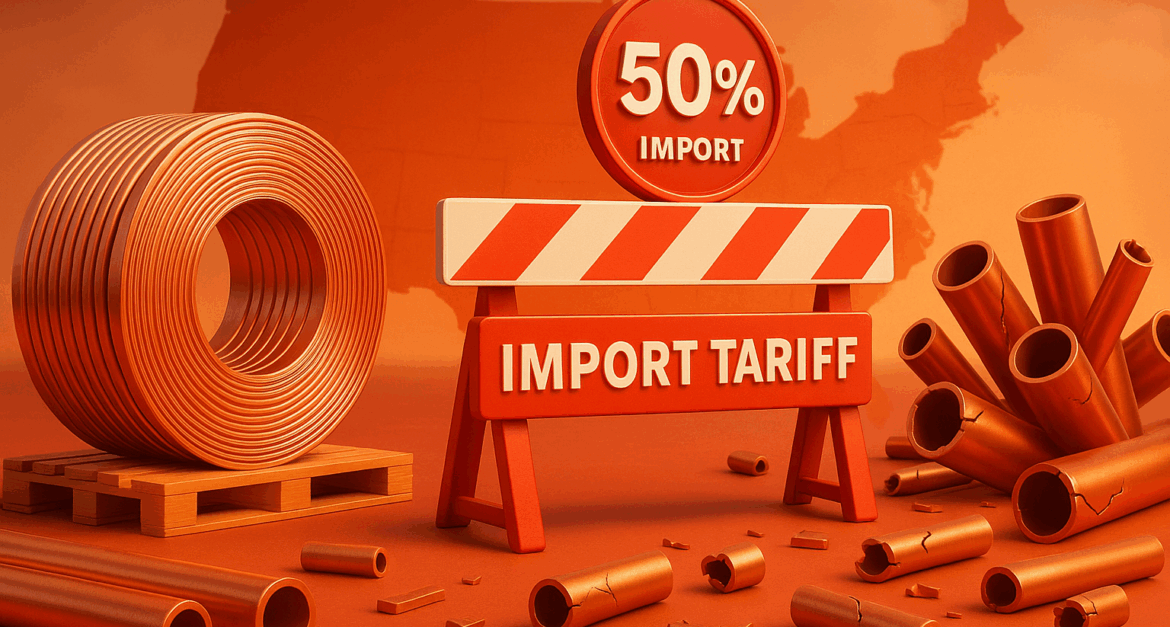
Introduction: One Metal, Many Ripples
On August 1, 2025, the U.S. will impose a 50% customs duty on all imported copper—a decision that’s sending immediate shockwaves across the global supply chain. Copper isn’t just a raw material—it’s a foundation of modern infrastructure, electronics, clean energy, and automotive manufacturing.
For logistics leaders, this isn’t just a pricing issue—it’s a planning crisis. From container ports to inland fulfillment centers, this tariff reshapes costs, reroutes freight, and challenges everything from procurement to delivery.
At AMB Logistic, we’re already working with shippers, importers, and supply chain operators to mitigate the coming impact—and this blog breaks down what you need to know now.
Why Copper? Why Now?
This sudden tariff isn’t arbitrary. The U.S. administration cites:
- Overdependence on foreign copper (notably from Chile, Peru, and Mexico)
- National security concerns tied to critical infrastructure
- A bid to revive domestic mining and smelting operations
Copper is essential for:
- Electric vehicles and batteries
- Renewable energy systems (solar panels, wind turbines)
- Housing and construction (wiring, plumbing)
- Data centers, telecom, and industrial machinery
With demand surging and domestic output stagnant, the tariff is positioned as a geopolitical and economic defense move. But the immediate reality? Higher costs and logistical complexity.
Immediate Impacts on the Logistics Chain
1. Port Congestion & Volume Shifts
Expect a pre-tariff import surge through late July, especially at Gulf Coast and West Coast ports. Importers are rushing shipments to beat the tariff clock.
AMB Action:
We’ve already increased drayage availability near Houston, Long Beach, and Savannah for copper-related loads.
2. Rate Volatility for Outbound Freight
As importers stockpile, outbound loads of finished goods (e.g., electric components, HVAC units, vehicle parts) may increase in volume, raising spot rates in key trade lanes.
Hot Lanes to Watch:
- Southern California → Midwest
- Gulf Coast → Southeast & East Coast
- New Jersey → Canada (EV assembly)
3. Warehousing & Transload Pressure
The copper tariff creates unpredictable inventory cycles. Distributors may overstock, delay fulfillment, or move product to temporary hubs.
AMB Action:
Our clients using metal-based SKUs now receive surge-forecasting reports and warehouse space recommendations within 100 miles of major port entry points.
4. Cost Surges in Contract Logistics
Higher commodity prices mean cost re-evaluations across:
- Contract manufacturing
- Distribution center service agreements
- Value-added services (e.g., kitting, sub-assembly)
Shippers must reprice BOMs and shipping agreements quickly—or risk being locked into loss-heavy rates.
Industries That Will Feel It First
The 50% copper tariff will hit B2B supply chains hard, particularly in:
- Automotive: EV makers will face battery and harness pricing pressures
- Construction: Developers may see delays on copper-based materials
- Telecom/Infrastructure: 5G rollout and fiber optic projects could be slowed
- Clean Energy: Utility-scale solar and wind installs may cost more or delay procurement
How to Respond: AMB Logistic’s 5-Point Plan for Shippers
1. Audit Your Copper Exposure
Check your top SKUs and suppliers. How many rely on copper wiring, tubing, batteries, or parts?
2. Diversify Import Sources
Explore alternate suppliers in tariff-free zones or countries with existing U.S. trade agreements.
3. Rethink Container Strategy
Use shared containers or LCL freight to offset cost increases per unit. Reduce bulk shipment dependency.
4. Time Your Inventory Intelligently
Consider bringing in Q3-Q4 volume earlier—if storage allows—and avoid reactive purchasing in September.
5. Partner With Agile 3PLs
Speed and flexibility will matter more than ever. Choose providers who can reroute loads, optimize drayage, and warehouse dynamically.
What AMB Logistic Is Doing Now
We’ve launched our Copper Tariff Response Program for importers and downstream manufacturers. It includes:
- Real-time freight rate monitoring in copper-heavy lanes
- Pre-tariff priority booking for early container moves
- Dynamic warehouse allocation across key port-adjacent hubs
- Customs advisory support to help clients review HTS codes and tariff exemptions
Conclusion: A Metal That Moves Markets
Copper may not be glamorous—but it’s essential. And when it becomes 50% more expensive overnight, the entire logistics chain feels the surge.
AMB Logistic is here to keep your freight moving, your inventory flowing, and your pricing under control—even in uncertain times.
We’ll help you move with precision—not panic.
Contact AMB Logistic
📧 info@amblogistic.us
🌐 www.amblogistic.us
📞 +1 (888) 538-6433
Tags: Copper Tariff, U.S. Supply Chain 2025, Import Cost Forecasting, Freight Rate Impact, Port Congestion, EV Logistics, Metal Imports, BOM Costing, AMB Crisis Support, Commodity Logistics Strategy




